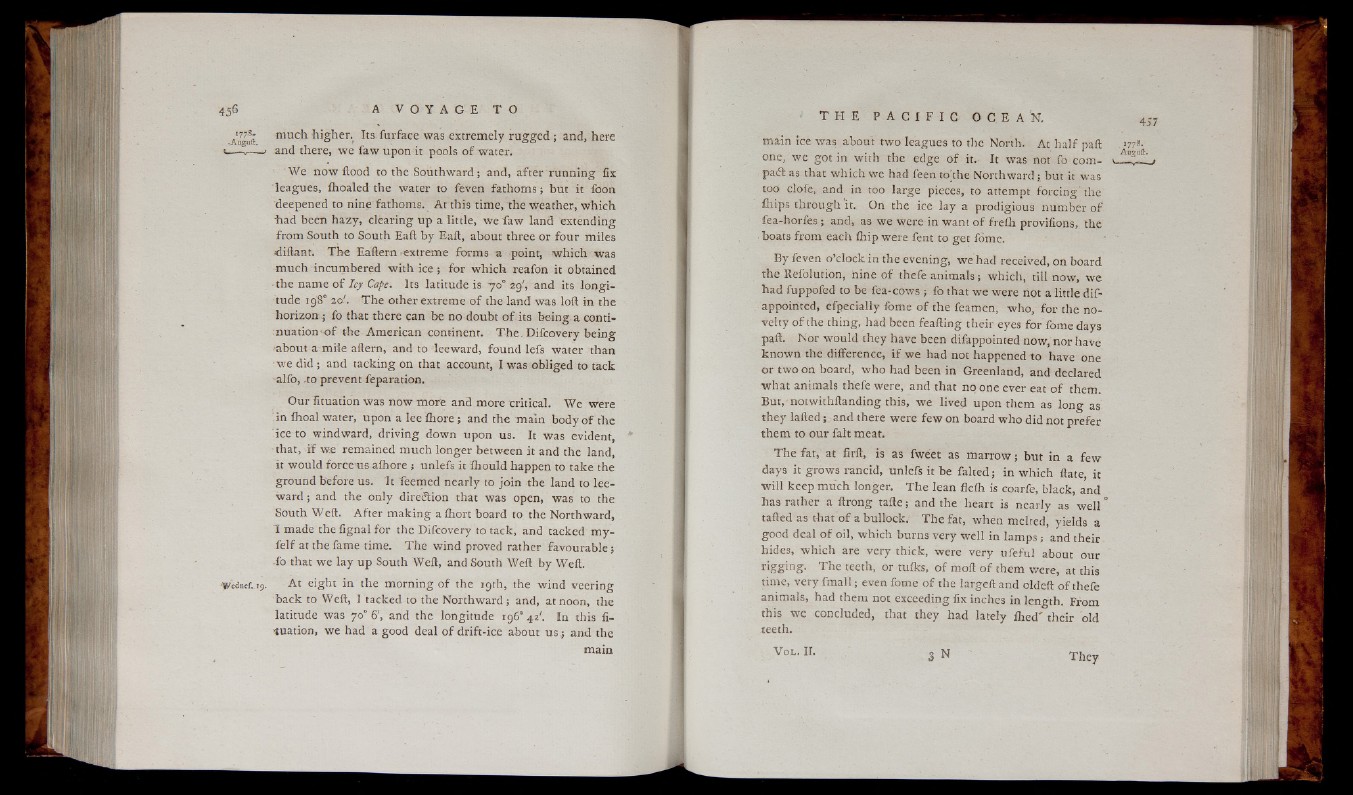
A' 77^ much higher. Its furface was extremely r u g g e d ; and, here
i— v-— > and there, we faw upon it pools o f water.
'We n ow flood to the Sou thw a rd ; and, after runn in g fix
leagu es, fhoaled the water to feven fathom s ; but it foon
deepened to nine fathoms. At this time, the weather, w hich
had been h a zy , clearing up a little , we faw land extending
from South to South Eaft by Eaft, about three or four miles
diflant. T h e Eaflern extreme forms a point, w h ich was
much incumbered with i c e ; for w hich reafon it obtained
• the name o f Icy Cape. Its latitude is 70° 29', and its lo n g itude
198' 2a'. T he other extreme o f the land was loft in the
horizon ; fo that there can be no doubt o f its being a conti-
nuation o f the American continent. T h e . Difcovery being
■about a mile aftern, and to leeward, found lefs water than
w e d id ; and tacking on that account, I was obliged to tack
alfo, .to prevent reparation.
Our fituation was n ow more and more critical. We were
in ihoal water, upon a lee ihore ; and the main body o f the
ice to windward, driving down upon us. It was evident
that, i f we remained much longer between it and the land,
it would fo rcen s afhore ; unlefs it ihould happen to take the
ground before us. It Teemed nearly to jo in the land to leeward
; and the only direction that was open, was to the
South Weft. After m akin g afhort board to the Northward,
1 made the fignal for the Difcovery to tack, and tacked my-
fe lf at the fame time. The wind proved rather favourable ;
fo that we la y up South Weft, and South Weft by Weft.
-Wednef. i j . A t eight in the morning o f the igrh, the wind veering
ba ck to Weft, I tacked to the Northward; and, at noon, the
latitude was 70° 6', and the longitude 196* 42'. In this fituation,
we had a good deal o f drift-ice about us.; and the
main
main ice was about two leagues to the North. At h a lf paft
one, we got in with the edge o f it. It was not fo com-
padt as that which we had feen to'the No rthward; but it was
too clofe, and in too large pieces, to attempt forcing' the
fhips through it. On the ice la y a prodigious number o f
fea-horfes ; and, as we were in want o f freih provifions, the
boats from each ihip were fent to get fome.
By feven o ’clock in the evening, w e had received, on board
the Refolution, nine o f thefe a n im a ls ; which, till now, we
had fuppofed to be fea-cows ; fo that w e were riot a little disappointed,
efpecially fome o f the feamen, who, fo r the novelty
o f the thing, had been feafting their eyes for fome days
paft. Nor would they have been difappointed now, nor have
kn ow n the difference, i f we had not happened to have one
or two on board, who had been in Greenland, and declared
w h a t animals thefe were, and that no one ever eat o f them.
But,' notwithftanding this, w e lived upon them as lon g as
they lafted; and there were few on board who did not prefer
them to our fait meat.
T he fat, at firft, is as fweet as m a r row ; but in a few
days it grows rancid, unlefs it be fa lted ; in which ftate, it
w ill keep much longer. T h e lean flefli is coarfe, black, and
has rather a ftrong tafte ; and the heart is nearly as w e ll °
tailed as that o f a bullock. T h e fat, when melted, yields a
good deal o f oil, which burns very well in lam p s ; and their
hides, w hich are very thick, were ve ry ufe fu l about our
rigging- T h e teeth, or tufks, o f moft o f them were, at this
time, ve ry fm a ll; even fome o f the largeft and oideft o f thefe
animals, had them not. exceeding fix inches in length. From
this we concluded, that they had lately ih ed ' their old
teeth.